
The Eurasian eagle-owl is a species of eagle-owl, a type of bird that resides in much of Eurasia. It is often just called the eagle-owl in Europe and Asia.

The spot-bellied eagle-owl, also known as the forest eagle-owl is a large bird of prey with a formidable appearance. It is a forest-inhabiting species found in the Indian Subcontinent and Southeast Asia. This species is considered part of a superspecies with the barred eagle-owl, which looks quite similar but is allopatric in distribution.

The owl butterflies are species of the genus Caligo and are known for their huge eyespots, which resemble owls' eyes. They are found in the rainforests and secondary forests of Mexico, Central and South America.

The spectacled owl is a large tropical owl native to the neotropics. It is a resident breeder in forests from southern Mexico and Trinidad, through Central America, south to southern Brazil, Paraguay, and northwestern Argentina. There are six subspecies. One is occasionally treated as a separate species called the short-browed or brown-spectacled owl but the consensus is that it is still merely a race until more detailed analysis can be done.

The Australian masked owl is a barn owl of Southern New Guinea and the non-desert areas of Australia.

The Oriental bay owl is a species of bay owl. It is completely nocturnal, and can be found throughout Southeast Asia and parts of India. It has several subspecies. It has a heart-shaped face with earlike extensions. The Congo bay owl was formerly classified as a subspecies of Oriental bay owl due to insufficient knowledge, but it has turned out that it might not even belong to the same genus. The Sri Lanka bay owl was also considered a subspecies.

The tawny-bellied screech owl is a species of owl in the family Strigidae. It is found in Bolivia, Brazil, Colombia, Ecuador, French Guiana, Guyana, Peru, Suriname, and Venezuela.

The rufous owl, also known as the rufous boobook, is a species of owl in the family Strigidae. It was described in 1846 by John Gould, an English ornithologist. Its common name reflects the rufous-coloured feathers that these owls are covered with in adulthood. While it is uncommon, the species has a wide range, including Australia, Indonesia, and Papua New Guinea.
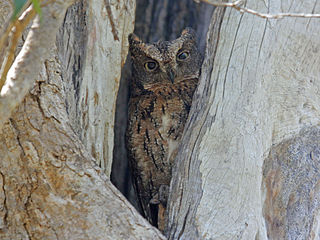
The Madagascar scops owl, also known as the Malagasy scops owl or Rainforest scops owl, is a species of owl in the family Strigidae. It is found throughout Madagascar, now that it has recently been lumped with the Torotoroka scops owl, with which it was long considered a separate species from. The nominate O. r. rutilus is referred to as Rainforest scops owl.

Caligo eurilochus, the forest giant owl, is an owl butterfly ranging from Mexico, through Central America, to the Amazon River basin in South America. It is a very large butterfly, among the largest in its family, with a wingspan up to 17 centimetres. The type locality is Suriname.
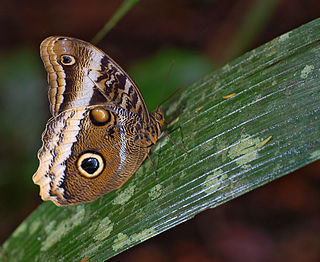
Caligo atreus, the yellow-edged giant owl, is a butterfly of the family Nymphalidae. The species can be found from Mexico to Peru.
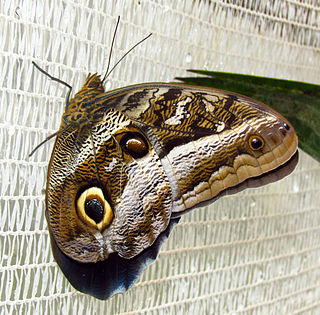
Caligo idomeneus, the Idomeneus giant owl, is a butterfly of the family Nymphalidae. The species can be found in the Amazon rainforest and eastern Andes, from Venezuela to Ecuador, and south to the Mato Grosso in southern Brazil. The butterfly is named for Idomeneus, the leader of the Cretan army during the Trojan War.
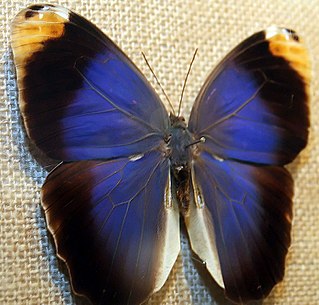
Caligo beltrao, the purple owl, is a butterfly of the family Nymphalidae. The species can be found in Brazil.
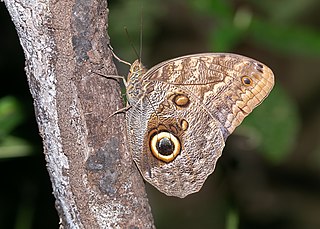
Caligo brasiliensis, the Brazilian owl, sulanus owl, or almond-eyed owl, is a butterfly of the family Nymphalidae. The species can be found in most of South America as various subspecies, including Brazil, Colombia, Venezuela and Ecuador. Its range extends through Trinidad, Honduras, Guatemala and Panama north to Mexico.
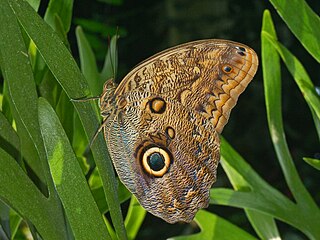
Caligo illioneus, the Illioneus giant owl, is an owl butterfly belonging to the nymphalid family, Morphinae subfamily, tribe Brassolini.
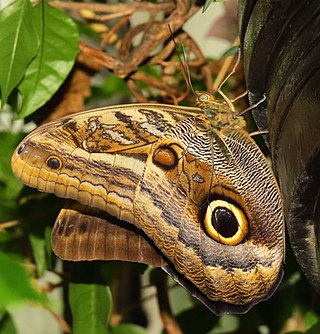
Caligo oileus, the Oileus giant owl, is a butterfly of the family Nymphalidae.

Caligo teucer, the Teucer owl butterfly is a butterfly of the family Nymphalidae. It was described by Carl Linnaeus his 1758 10th edition of Systema Naturae. It is found from Colombia and Venezuela to Bolivia and Paraguay. The habitat consists of rainforests and cloudforests at altitudes ranging from 400 to 1,400 meters.

Ninox boobook ocellata is a subspecies of the Australian boobook, which is also widely known as the southern boobook. The southern boobook is the most common and smallest owl on the Australian mainland.
The Spirogyra Butterfly Farm Park Garden,, located in San Francisco de Goicoechea, on the edge of Rio Torres, north of Zoológico Simón Bolívar, in Barrio Amon, Carmen District, San José, Costa Rica, is a butterfly house that houses from 50 to 60 different species of live butterflies from around the country in a climate-controlled, glass-enclosed habitat.

Caligo telamonius is a brush-footed butterfly. The species was first described by Cajetan von Felder and Rudolf Felder in 1862. It is found in southern North America, Central America, and South America.























